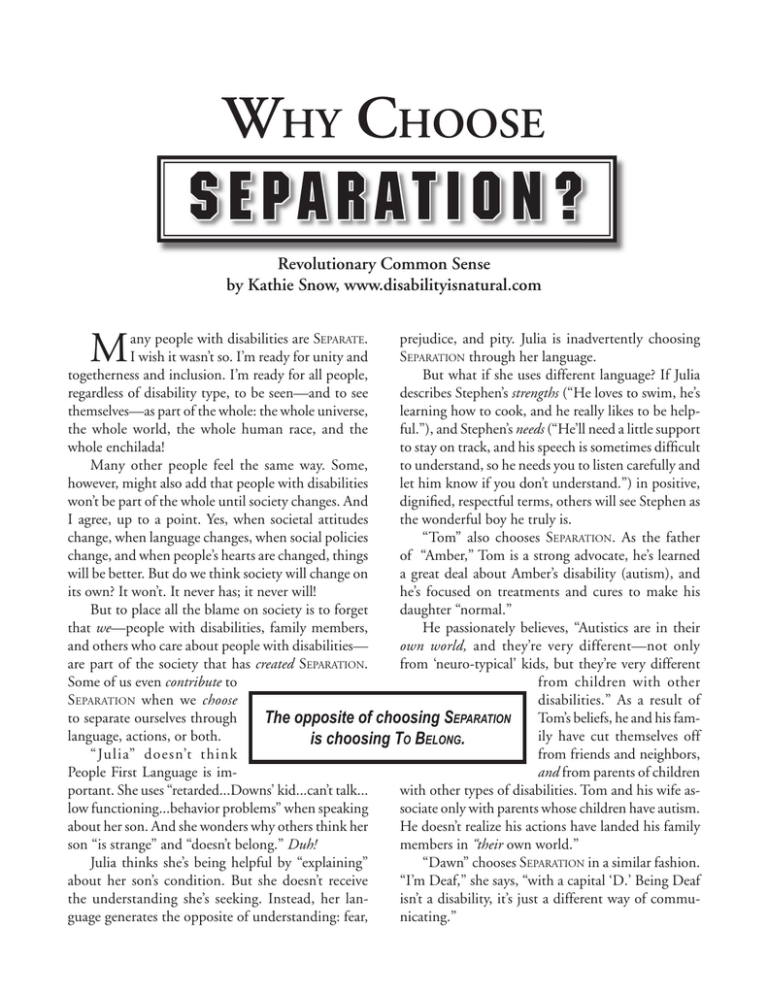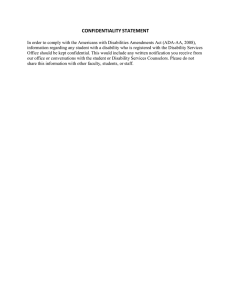
WHY CHOOSE
Separation?
Revolutionary Common Sense
by Kathie Snow, www.disabilityisnatural.com
M
any people with disabilities are SEPARATE.
prejudice, and pity. Julia is inadvertently choosing
I wish it wasn’t so. I’m ready for unity and
SEPARATION through her language.
togetherness and inclusion. I’m ready for all people,
But what if she uses different language? If Julia
regardless of disability type, to be seen—and to see
describes Stephen’s strengths (“He loves to swim, he’s
themselves—as part of the whole: the whole universe,
learning how to cook, and he really likes to be helpthe whole world, the whole human race, and the
ful.”), and Stephen’s needs (“He’ll need a little support
whole enchilada!
to stay on track, and his speech is sometimes difficult
Many other people feel the same way. Some,
to understand, so he needs you to listen carefully and
however, might also add that people with disabilities
let him know if you don’t understand.”) in positive,
won’t be part of the whole until society changes. And
dignified, respectful terms, others will see Stephen as
I agree, up to a point. Yes, when societal attitudes
the wonderful boy he truly is.
“Tom” also chooses SEPARATION. As the father
change, when language changes, when social policies
of “Amber,” Tom is a strong advocate, he’s learned
change, and when people’s hearts are changed, things
will be better. But do we think society will change on
a great deal about Amber’s disability (autism), and
its own? It won’t. It never has; it never will!
he’s focused on treatments and cures to make his
But to place all the blame on society is to forget
daughter “normal.”
that we—people with disabilities, family members,
He passionately believes, “Autistics are in their
and others who care about people with disabilities—
own world, and they’re very different—not only
are part of the society that has created SEPARATION.
from ‘neuro-typical’ kids, but they’re very different
from children with other
Some of us even contribute to
disabilities.” As a result of
SEPARATION when we choose
to separate ourselves through
Tom’s beliefs, he and his famThe opposite of choosing SEPARATION
ily have cut themselves off
language, actions, or both.
is choosing TO BELONG.
from friends and neighbors,
“Julia” doesn’t think
and from parents of children
People First Language is imwith other types of disabilities. Tom and his wife asportant. She uses “retarded...Downs’ kid...can’t talk...
sociate only with parents whose children have autism.
low functioning...behavior problems” when speaking
He doesn’t realize his actions have landed his family
about her son. And she wonders why others think her
son “is strange” and “doesn’t belong.” Duh!
members in “their own world.”
Julia thinks she’s being helpful by “explaining”
“Dawn” chooses SEPARATION in a similar fashion.
about her son’s condition. But she doesn’t receive
“I’m Deaf,” she says, “with a capital ‘D.’ Being Deaf
the understanding she’s seeking. Instead, her lanisn’t a disability, it’s just a different way of communicating.”
guage generates the opposite of understanding: fear,
2 - Why Choose Separation?
People who are familiar with my work know that
I’m trying to create positive change in attitudes and
perceptions about individuals who have what the
sociopolitical arena has defined as “disabilities.” To
that end, I teach that a disability can be redefined as
a “body part that works differently.” So I’m “with”
Dawn, up to a point. But Dawn, and others who
think like her, seem to distance themselves from the
majority of people with disabilities. Specifically, they
apparently believe they have nothing in common with
people who have physical, cognitive, or other types
of disabilities/conditions.
I’m the first one to agree that people with disabilities do not constitute a single homogenous group. At
the same time, there are times when people who share
similar circumstances and experiences—like being on
the receiving end of prejudice, misunderstanding,
marginalization, and devaluation—can benefit from
being in solidarity with each other around social and
legal issues, and they can learn from one another, irrespective of disability type!
When we choose SEPARATION, many opportunities
are lost. We lose opportunities to meet others and
learn from them. We lose opportunities to influence
the Real World. And, worst of all, we often sever opportunities to participate in the Real World.
Over the years, I’ve come to believe that the world
we see is simply a reflection of ourselves. If we believe
we’re different, we may consciously or unconsciously
say or do things that cause people to see us as different. It’s possible, however, that some people may not
actually see or treat us differently, but because we
think they will, we interpret their behavior to suit our
preconceived notions. In this way, we’re no different
from those we’re trying to influence: people who can’t
see the real person behind the disability because their
vision is clouded with preconceived notions.
The opposite of choosing S EPARATION is
choosing TO BELONG. And choosing TO BELONG is
easier than you might think!
Use People First Language: Rid your thoughts
and vocabulary of words that focus on a person’s
diagnosis or perceived deficits, and which include stereotypes or medical jargon. Think and speak in ways
that promote a person’s strengths, gifts, and abilities.
Reframe “problems” into “needs.” I don’t say my son
“can’t walk,” I say, “My son needs/uses a wheelchair.”
(See the article “The Problem with ‘Problem’.”)
When/if you need to discuss a person’s needs, do so
in ways that promote dignity and respect.
Become Normal—Typical—Average: See
yourself as, and become, a “regular”—not a “special”—person/family. When we see ourselves as
“special/different/pitiful” or whatever, others will
see us that way, too—and exclusion/social isolation
is the outcome!
Expect Inclusion: Inclusion is, first and foremost,
a state of mind. See yourself and/or your family members as citizens of your community who belong!
Join the Real World: “Disability World”—special services and/or segregation (including groups we
join)—can be a place to visit now and then, but it’s
not the Real World! Connect with people/groups with
whom you and your family share similar interests.
Yes, in joining a “disability group,” you’re with others
who share a common interest. But if this involvement
increases SEPARATION, it’s not a healthy situation for
you or your family. So get involved in ordinary community activities!
Our beliefs direct our actions. So believe you’re
included, believe you’re part of your community,
believe you’re part of the Real World, and the actions
to make it a reality will follow.
I want to change The World. But I can’t. It’s too
big. I can, however, effect change in My World, which
includes myself, my family, my neighborhood, my
community, and others in my sphere of influence.
When enough of us influence our individual worlds,
the bigger World will be changed, and the SEPARATION of people with disabilities will become a distant
nightmare.
©2002-07 Kathie Snow; all rights reserved. You may photocopy to share with others (in its entirety), as a handout. Please share how/when you
use it: kathie@disabilityisnatural.com. This is the intellectual property of Kathie Snow and is protected by Copyscape: permission is required
before republishing in newsletters, on websites, etc. To learn more new ways of thinking, to sign up for the Disability is Natural E-Newsletter,
or to learn about Disability is Natural books, DVD, and products that promote positive images, visit: WWW.DISABILITYISNATURAL.COM.







